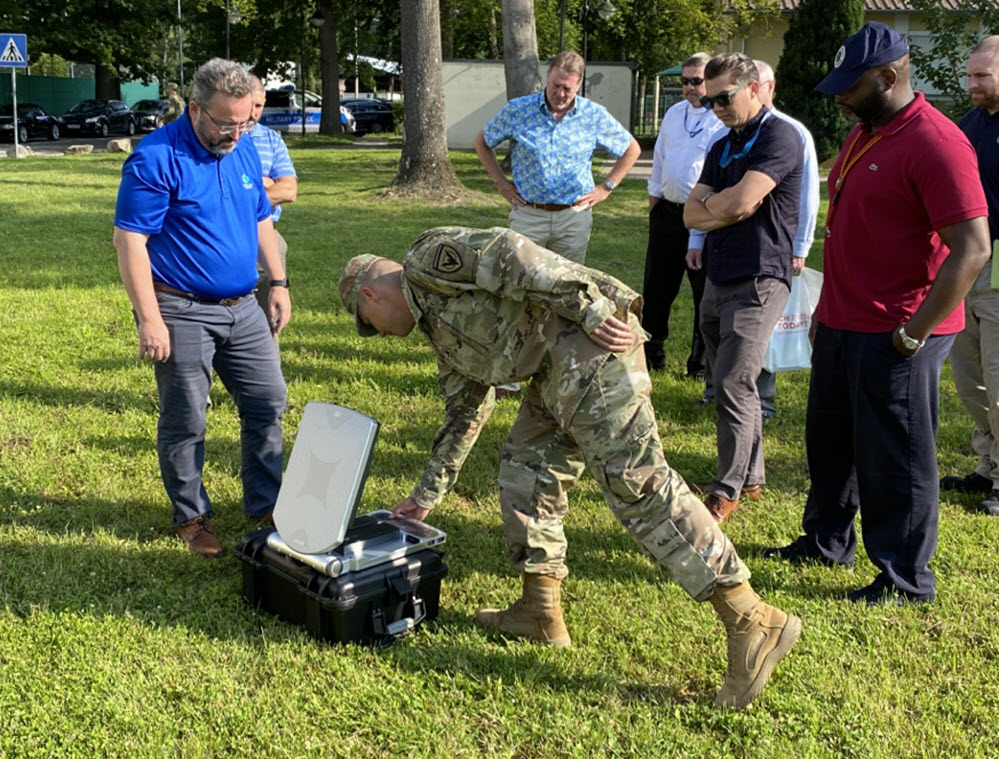
Intelsat’s FlexMove for Government managed service solution meets the connectivity needs of land-mobile operations. Shown are Intelsat personnel demonstrating FlexMove in Germany.
Deployed ground teams require instantaneous access to secure, high-data-rate communications to ensure fast and effective decision-making. Connectivity for C4ISR (Command, Control, Communications, Computers, Intelligence, Surveillance, Reconnaissance) were vital capabilities during the Global War on Terror and will evolve into even more important warfighting tools for the Great Power competition.
In this Q&A with David Micha, president of Intelsat General, we discuss the state of Satcom, satellite-based capabilities for all-domain operations, and new subscription models for pay-as-you-go managed services.
Breaking Defense: How is the military using Satcom today, compared to how it was used at the height of the Global War on Terrorism?
Micha: Dynamics are always changing but in many ways some things haven’t changed. In general, Satcom was a key component when the Global War on Terrorism was hot and heavy. And even today the military continues to drive Satcom activity all the way down to the lower echelons. It’s critical to the warfighting effort. It was then, and it is now.
Something else that hasn’t changed and won’t change going forward is unmanned aerial ISR. It has been and will continue to be important in the Global War on Terrorism, and we’re not even talking about near-peer threats yet. It’s just the way the military conducts operations.
What has changed, though, is that Satcom and ISR were very concentrated efforts. Now military operations are more distributed. The number-one issue in the Pentagon is China. Of course, there’s Russia, North Korea, and every other bad actor in the world. But China is the number-one threat. That means our military operations are becoming much more distributed and Satcom will play a key role in that. Instead of being highly concentrated in one geographic region, it’s going to be more global.
The other big difference is that the networks we’re using now versus five years ago are much more flexible, capable, and reconfigurable, while our terminals have better size, weight, and power characteristics so they’re easier to move around.
All that is enabled by the next generation of satellites that are more powerful and flexible, with more focused coverage areas. Those are some of the big differences. The threat is changing and the location is more distributed, but Satcom is going to continue to be a very important warfighting element as we go forward.
Breaking Defense: How will Satcom be used in the near-peer/peer Great Power competition? Why is the ability to transmit/receive data on the move key for all-domain operations?
Micha: When you think about all-domain operations against a near-peer threat—whether it’s space, air, ground, maritime, and cyber—we are not going to be able to operate unimpeded. We are not going to necessarily control all the airspace all the time like we have for the last 20 years. So Satcom is going to be a key component in the preparation of the battlefield by providing ISR data and situational awareness.
In addition, we frankly don’t have enough manned platforms in some areas or enough staffing to man all the platforms. So unmanned systems are going to be the wave of the future.
They’re going to operate autonomously, in swarms, and they’re going to have to operate with manned platforms. All that happens through a network of Satcom links. That’s how they’re going to move data back and forth for the various domains we have to operate in.
In addition, UAVs have to be secure. They have to be LPI/LPD (low probability of intercept/low probability of detection), and they have to be able to transmit and receive on the move for command and control data, sensor data, and other ground, air, sea, and space data. That’s where Joint All-Domain Command and Control pulls everything together. Satcom is going to be a key piece of that to securely move that data.
Breaking Defense: Intelsat has introduced the FlexMove for Government managed service solution to meet the comms-on-the-pause and comms-on-the-move connectivity needs of land-mobile operations. What’s the driver behind FlexMove?
Micha: It came down to flexibility. Some government customers want what they want, want it all the time that they want it, and are willing to pay for that. There are other customers who want capability, but they don’t need it all the time. They just need to be able to access it when they need it. So they don’t really want to pay for full-time usage.
We are offering a number of subscription packages that let customers customize their mission and their budget. It gives them more flexibility depending on their mission CONOPS. If they’re working in a high-threat environment like nuclear command and control, for example, they need an always-there capability. If they just need connectivity sporadically, maybe on a terminal by terminal basis depending on where they are, then they may want to pay as they go under our FlexMove model.
Breaking Defense. Talk a little more about the military missions appropriate to the FlexMove pay-as-you-go model.
Micha: There are missions that are known and planned months in advance. We’re going to be flying on this day or we need connectivity on that day. We’re only doing something in the morning or only at night. Those people have a much more structured operational environment that works well as a pay-as-you-go approach.
Then there are other military missions where flexibility is important because they need immediate readiness. Think of disaster-preparedness organizations that need to deploy tomorrow afternoon for a hurricane that’s hitting some place today. Or any mission that doesn’t allow for advance preparation.
It provides cost savings to the customer who doesn’t wish to purchase a service when it’s not used. Rather, it lets them more cost effectively take advantage of spur-of-the-moment missions.
Breaking Defense: FlexMove is also a managed service, as you mentioned. What are the advantages of that?
Micha: Warfighters have a lot to do and a lot to worry about. What they shouldn’t have to worry about is all the infrastructure that’s needed to conduct their mission. With managed services, all the headaches are removed from the warfighter by having the satellite network provisioned and managed for them so that they can just conduct their mission.
I liken it to working in an office environment with a computer. Your job is to create value for the company. What you don’t want to be doing is tinkering around with the system because your printer is not working. You want all that handled for you so you can just do your work. It’s the same thing with warfighters. FlexMove provides a comprehensive, fully managed network that’s provisioned, frequency managed, and has the proper terminals. That’s going to save them a lot of headaches.
This model also reduces the need for highly trained and expensive field engineers to do things like activating the antenna. If something has to be engineered to be set up, then it’s complex by nature and it’s expensive. An analogy I would give you is an iPhone. When you buy one, you basically turn it on and it works, right? It doesn’t require three people from the store to help you get it going.
When the provisioning service is outsourced to a company like Intelsat, it provides these capabilities at scale because we have thousands of customers with thousands of daily needs. It’s just less costly and takes the burden away from the warfighter.
Breaking Defense: You’re conducting a roadshow of military bases to demonstrate this service. What are the main points you’re getting across?
Micha: To me, demos are the most powerful tool to show a warfighter what we can do for them. These demos have a variety of objectives. We want to show them that we have broadband connectivity across a small-form-factor, mobile manpack for comms-on-the pause that operates on a varying number and type of end-user terminals. That’s important because different customers, different organizations use different terminals.
The other parameter we like to show in the demo, quite frankly, is the high performance that they get all the way out to tactical-edge applications. We have state-of-the-art, high-throughput satellites, and we’re launching new software-defined satellites that are at the cutting edge of satellite technology. Along with the technology, we give them a total connectivity package—high range, both low cost and flexible cost, a varying number of terminals, and the managed services that let them do their mission and not worry about the rest.
Breaking Defense: You also sell a similar model for aviation called FlexAir for Government. Tell me about that.
Micha: Yes, FlexAir for airborne applications and FlexMove for land mobile are very similar. It’s a bit different because installing an antenna on an aircraft is a little more challenging than just throwing it in the back of a Jeep or setting it up on the ground. Every military service is looking for Satcom connectivity on almost all of their airborne platforms. We believe FlexAir is a great product that provides a globally comprehensive managed service.
We rolled out FlexMove and are now gaining traction with FlexAir. Similar to FlexMove, FlexAir is a managed service that can be applied to the Global War on Terrorism or against near-peer threats. The military needs that warfighting connectivity and FlexAir serves that function from an airborne standpoint.
Breaking Defense: You mentioned ISR earlier. Is FlexAir targeted at something like a King Air surveillance platform?
Micha: It could go on anything from a Navy P-8 to a King Air ISR platform that’s doing full-motion video or signals intelligence to a blue and white aircraft for the presidential fleet. So, yes, King Air would be a perfect choice.
Breaking Defense: Final thoughts?
Micha: Intelsat as a company has decades of experience doing work with the U.S. government, has more satellites and tremendous coverage from a commercial standpoint than any commercial satellite operator. We have a prodigious, interactive, proliferated ground infrastructure around the world with our hubs and teleports. I’m also very excited about our next-generation network ecosystem—a software-defined network integrated with 5G enabling next-generation mobility, seamless IoT, and cloud solutions.
When you go to a managed service approach like FlexAir or FlexMove, you are getting high-throughput connectivity using smaller, lighter, lower-power terminals, ground facilities staffed by cleared personnel, as well as global coverage at reasonable and affordable rates.






















